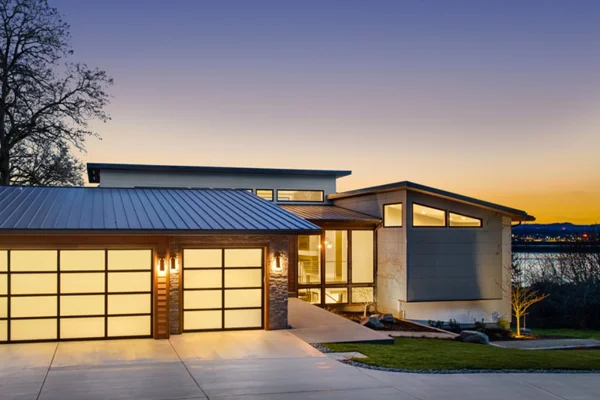Combining engineering with architecture is crucial for creating safe, practical, and aesthetically pleasing buildings and structures.
While engineering and architecture are two separate but linked disciplines, working together can lead to better building ideas and construction methods.
Creating useful and aesthetically acceptable designs is the responsibility of architects. The basic layout, aesthetics, and usage of the building are all things they focus on. Engineers, on the other hand, focus on the technical aspects of the building, including structural integrity, safety, and efficiency. They work on the details of how the building will be constructed, such as the materials and systems needed to make it work.
Working together, architects and structural engineers can create a structure that is not only aesthetically pleasing but also safe and practical. Together, they discover potential design issues and develop solutions that strike a balance between the demands of form and function. For instance, engineers may labour to develop a design that satisfies the safety criteria while still keeping the beauty of the structure when architects construct a building with big, open spaces that necessitate particular structural supports.
Working together is essential between engineers and architects during the project’s building phase. Engineers collaborate closely with the building team to make sure the structure is being built in accordance with the design standards. If they discover that the design cannot be implemented or built as intended, they may change it. Contrarily, architects collaborate closely with the building crew to ensure that the design concept is upheld throughout the construction phase.
Buildings must combine engineering and architecture in order to be both aesthetically beautiful and secure. Cooperation between these two disciplines is necessary to fulfil both the technical requirements and the design goal. In order to detect potential design issues and develop solutions that strike a balance between beauty and usefulness, architects and engineers must collaborate. If issues arise, engineers can contribute their forensic engineering services to discover and resolve the problem.
Benefits of a collaborative approach between Architects and Engineers
There are many benefits to a collaborative approach between architects and engineers, including:
Improved Design
When engineers and architects work together, they can produce ideas that are both visually beautiful and sound structurally. Engineers can contribute their technical knowledge to the design process, assisting architects in comprehending what is technically viable and useful. Similar to this, architects can offer suggestions for the design that will enhance both its aesthetic appeal and user experience.
Enhanced Efficiency
Cooperation between engineers and architects can increase the effectiveness of a project. Together, they can spot possible concerns and come up with remedies before they grow into larger ones. In the course of the design and construction process, this could assist save time and money.
Improved Communication
Working jointly can enhance communication between engineers and architects. They might work together to get to an understanding on the technical specifications and design goals in order to prevent misunderstandings and conflicts.
Increased Innovation
Cooperation between engineers and architects can boost innovation. They can develop fresh concepts and methods for building design and construction by fusing their distinctive viewpoints and experience.
Better Quality
The joint efforts of engineers and architects may result in superior buildings. Together, they can guarantee that the structure is constructed to the best standards possible with regard to its usability, security, and aesthetic appeal.
Working together can generally lead to better communication, more effective structures, and more inventiveness. Together, these two groups can design and build structures that are both aesthetically pleasing and sound structurally. We at Engineering Sydney we pride ourselves on our ability to collaborate with others in order to achieve outstanding results that boast both cost-effective and sustainable benefits.

How can it lead to more efficient and sustainable building designs?
Collaboration between architects and engineers can lead to more efficient and sustainable building designs in several ways, including:
Early Identification of Sustainability Goals
The sustainability objectives of the project can be determined early on in the design phase by architects and engineers working jointly. They can do this to make sure the building design satisfies these objectives and that the necessary systems and materials are incorporated into the design from the start.
Integration of Sustainable Strategies
Engineers and architects can collaborate to implement sustainable practices when developing a structure. For instance, experts can suggest energy-efficient HVAC systems, lighting choices, and renewable energy systems. Similar to this, architects can design buildings to maximise energy efficiency as well as natural ventilation and light.
Optimisation of Building Envelope
The building envelope, which is essential for energy efficiency, can be optimised with the help of collaboration between architects and engineers. Together, they may create structures with high-performance insulation, little heat absorption and loss, and a focus on long-lasting, ecological materials.
Use of Sustainable Materials
A structure’s engineers and architects may jointly select and use sustainable materials. Engineers can provide guidance on the technical aspects of these materials, such as their performance and durability, whilst architects may ensure that the materials match the project’s aesthetic and functional aims.
Consideration of Life Cycle Costs
Through cooperation between architects and engineers, the life cycle costs of the building design can be taken into consideration. In doing so, they might ensure that the structure is designed and constructed in a way that is reliable, inexpensive, and sustainable.
By incorporating sustainability goals early in the design process, optimising the building envelope, using sustainable building materials, taking life cycle costs into consideration, and incorporating sustainable strategies into the design, collaboration between architects and engineers can result in more efficient and sustainable building designs.
Because of this, architects and engineers must work together to create and build structures that are secure, useful, appealing to the eye, and environmentally friendly. Superior building design and construction outcomes can be achieved when the viewpoints and skill sets that architects and engineers bring to the table are merged.
Cooperation between engineers and architects has a number of benefits, including better design, enhanced efficiency, improved communication, increased innovation, and better-quality constructions. Together, architects and engineers can create buildings that are more effective and sustainable by incorporating sustainability goals early in the design process, optimising the building envelope, using sustainable materials, taking life cycle costs into account, and incorporating sustainable strategies into the design.
The structure will be planned and built in a way that is long-term sustainable and economical by doing this, according to architects and engineers. Collaboration between architects and engineers is becoming increasingly crucial in order to combat climate change and lessen the carbon footprint of buildings. Together, they could design buildings that are beautiful to look at and beneficial to the environment. This teamwork strategy may encourage innovation in building design and construction, resulting in more environmentally and energy-efficient structures.
In conclusion, it is crucial for architects and engineers to work together to design and create buildings that are sustainable, effective, and both aesthetically beautiful and technically sound. Together, engineers and architects must identify potential design issues, develop solutions that strike a balance between form and function, and incorporate sustainability tactics into the design. Better results for clients, the environment, and society at large may result from this collaboration.

